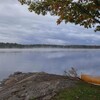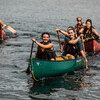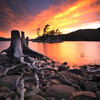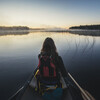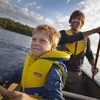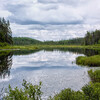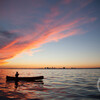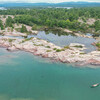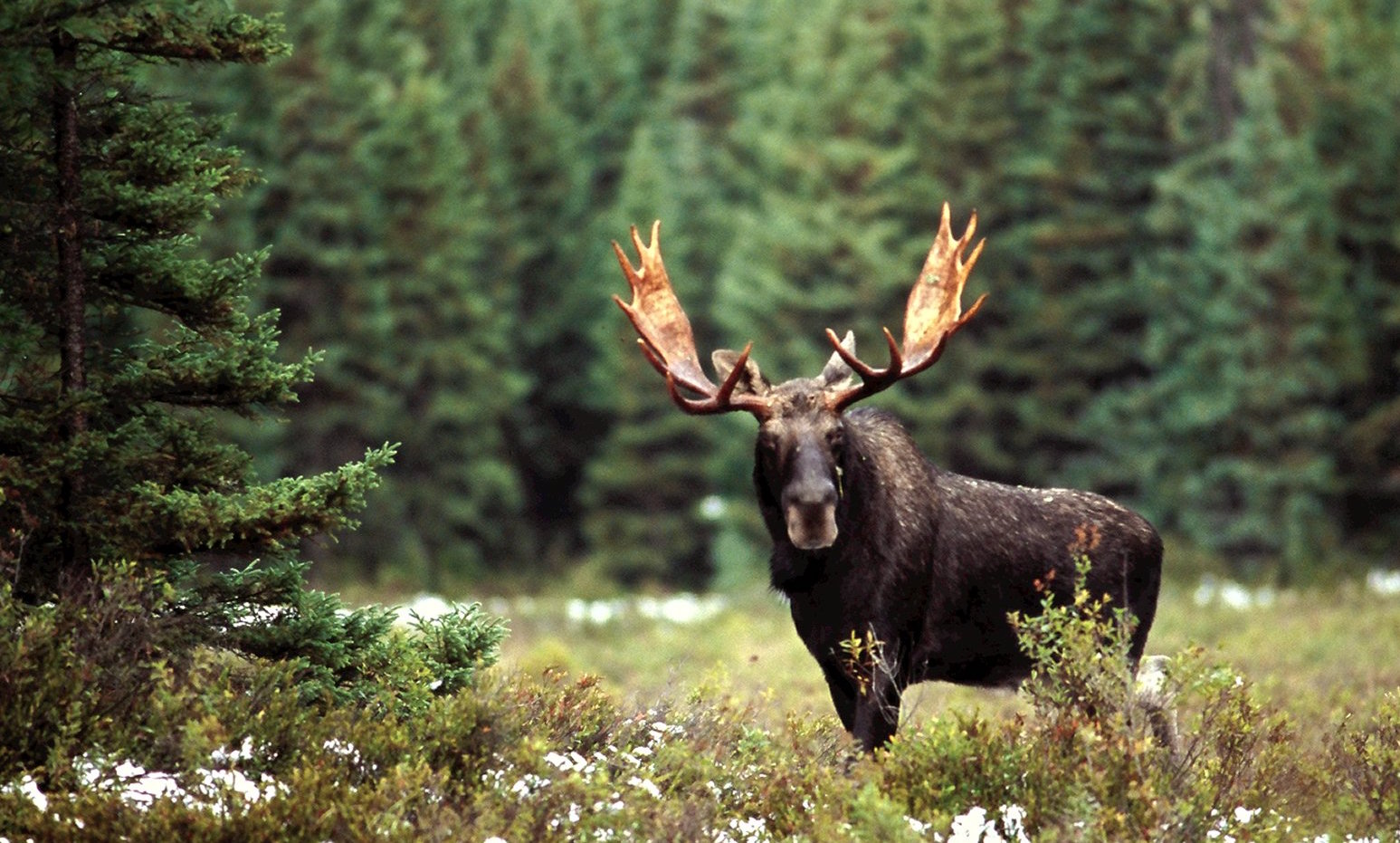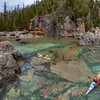
Best Places to Spot Moose by Canoe
There is no greater wilderness experience than paddling across a glassy lake at dawn while watching a moose munch on aquatic plants in the shallows. With close to 100,000 moose in the province, a canoe trip in Ontario’s backcountry is one of the best ways to view these elusive creatures. The breathtaking majesty of a wild moose is something you need to experience for yourself. So if you’re asking yourself, “Where can I see moose in Ontario?”, let this article guide you to some of the most picturesque, moose-dense backcountry paddling locations.
How to See Moose in Ontario
Patience, gratitude and composure are of the utmost importance when attempting to view any wildlife. Moose are powerful animals and can be dangerous. It’s essential to always maintain your distance. This is both for your safety as well as the animal’s safety—getting too close to the animal may cause it to retreat, abandoning a prime feeding location or habitat and unnecessarily using its limited energy resources.
Parks Canada recommends staying 30 meters (100 feet) away from moose at all times. Be aware that a moose may behave aggressively if it feels threatened. Move calmly to avoid spooking the animal and learn to identify aggressive moose behavior here. Take binoculars to get a better view from a safe distance.
Here are some tips on spotting moose in the wild:
- The best time of day to see a moose is in the morning and the early evening. Moose are most active at dawn and dusk.
- Concentrate your moose-spotting efforts on low-lying wet areas such as bogs, ponds and beaver meadows. This is prime moose habitat.
- The best time to see a moose from your canoe is between May and September. This aligns with the animal’s most active months and Ontario’s paddling season.
- Look for established game trails down to the water’s edge. Moose don’t like to work harder than they have to, so they will often stick to previously travelled routes.
- Familiarize yourself with the sight of moose scat. Identifying moose scat on the portage trail can help tell if a moose is nearby.
- Learn to identify moose prints. Have a look here to see some moose prints.
- Be patient. Sometimes you might spend many days in the backcountry without seeing a single moose, but when it does happen, it will be worth your while.
Best Places to See Moose While Canoe Tripping in Ontario
Moose Hotspot: Algonquin Provincial Park
Pristine views, endless lakes and nearly 2,000 backcountry sites await paddlers exploring Algonquin Provincial Park’s vast beauty. With an estimated 2,700 moose, Algonquin is widely known as one of Ontario’s prime moose-spotting habitats. Many paddlers have spotted a moose just driving the park’s Highway 60 corridor, and many more have sighted a moose from the bow or stern of their canoe while paddling and portaging the park’s interior.
Where to Go: Hailstorm Creek (2 to 3 days, intermediate)
Hailstorm Creek is located at the north end of Lake Opeongo, the largest lake in Algonquin Park. Due to the dangers of large lake travel, paddlers should be wary of the wind and possess strong paddling skills to traverse Lake Opeongo. You’ll need to reserve backcountry sites and obtain permits before departing on your trip.
Day 1: Head to the Lake Opeongo Access Point near Whitney, park your car and launch your canoe at the main dock. Paddle towards the lake’s North Arm to reach the Hailstorm Creek Nature Reserve. This will take four to six hours, depending on skill level. Set up camp on one of the backcountry sites near the reserve’s boundary on Lake Opeongo’s North Arm. Paddle through the wetlands in the evening and keep your eyes peeled for moose.
Day 2: Paddle back into the creek at dawn to maximize your chances of a moose sighting. After breakfast, some paddlers may choose to portage to either Redrock Lake or Proulx Lake. Both lakes can be reached by travelling moderately difficult portages, making them exceptionally peaceful locations for wildlife viewing. Pay close attention to the shorelines as moose may be feeding or drinking near the water on smaller lakes. Enjoy some quality fishing and a restful night in a less-travelled area.
Day 3: After breakfast, travel back to Lake Opeongo and spend the day taking in the scenery, watching for wildlife, stopping for snacks, and taking short breaks along the way. Return to the Lake Opeongo access point.
Outfitters and Guides
There are many places to see moose in Algonquin and the experienced guides at Algonquin Outfitters and Opeongo Outfitters offer guided excursions and route-planning services to help make the most of your backcountry paddling experience. You can also tailor your trip to moose spotting with Voyageur Quest’s three-day moose safari.
Algonquin Outfitters offers a self-guided day trip to Hailstorm Creek with water taxi dropoff to maximize your time looking for moose and wildlife. After your day of wildlife viewing, the outfitter will pick you up to return you to the Opeongo Access Point. Learn about this day trip here.
For canoe rentals, route planning advice, guided excursions or to pick up some top-tier equipment, visit Opeongo Outfitters, Voyageur Outfitting, Algonquin North, or Algonquin Outfitters.
Moose Hotspot: Wabakimi Provincial Park
The remote forest landscape is the perfect backdrop for skilled paddlers looking to see moose while canoeing. Wabakimi Provincial Park is one of the world’s largest backcountry paddling areas and the region is perfect for sustaining moose life. It is estimated that the surrounding area is home to as many as six moose per 100 km, with an estimated population of 1,700 to 2,300. Choosing to embark on a paddling trip in Wabakimi or along the Kokpa River will give you excellent opportunities to capture unhindered views of wildlife while challenging your skills as a backcountry paddler. Complete with rapids, drops and challenging portages, this route through the Canadian Shield is for experienced paddlers.
Where to Go: Kokpa River (10 to 12 days, intermediate to advanced)
Load your gear onto the train and take the Via Rail to the Allanwater Bridge Station in Wabakimi. Stay at the Allanwater Bridge Lodge or set up a tent nearby. Then head south towards Antler Lake and spend the following days paddling through rapids, portaging and watching for moose along the Kokpa River. The untouched scenery will make you feel as if you’re living in the past as you scan for wildlife and enjoy the fresh air.
Bukemiga Lake is a good take-out point. The end of the lake is close to the 527 highway and approximately 30 kilometres from the town of Armstrong Station. Organize a ride with a local outfitter to meet you at the take-out point, then stay at the Caribou Lodge while waiting to catch the train. The lodge offers fishing and hunting excursions for those interested in extending their trip.
Outfitters and Guides
As this can be a difficult trip to plan, use the expert services of an outfitter to help plan your specific route. Wabakimi Canoe Outfitters and Ecolodge and Mattice Lake Outfitters offer guided canoe trips, fly-in camping excursions, map services and rentals to help you plan the perfect trip. They can help with permits too. You can scout potential paddling routes for your trip by accessing the maps and guidebooks provided by the Friends of Wabakimi.
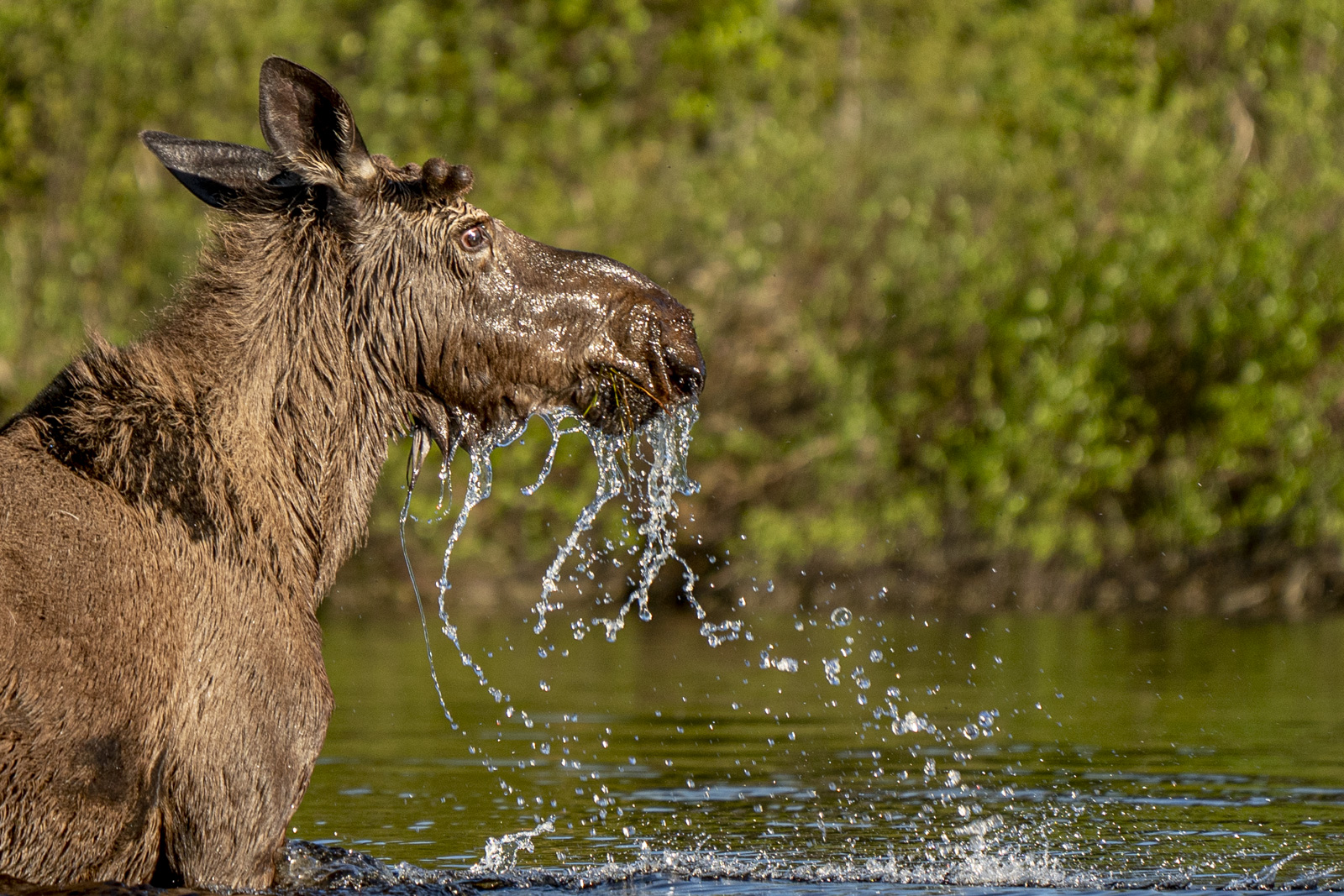
Moose Hotspot: Quetico Provincial Park
Quetico Provincial Park lies northwest of Lake Superior, just under two hours from Thunder Bay. For paddlers looking to explore the wilderness of northwest Ontario in search of wildlife such as black bears, white-tailed deer and moose; Quetico is the perfect spot. Considered to be some of the best canoeing in the world, the park is home to more than 2,000 lakes and 500 portages and has canoe routing options for everyone.
Where to Go: Nym Lake Access (3 to 6 days or more, intermediate)
The Batchewaung-Twin-Jean-Jesse Loop is a popular and challenging 6-day canoe loop with 18 portages and a variety of lakes, creeks and narrows. Put in at the Nym Lake Access, then paddle through Jean Creek, Oriana Creek and the Pickerel Narrows. While tripping, paddlers will pass through many shallow sections of water and petite lakes perfect for spotting moose.
Alternatively, take a 3-day trip with excellent wildlife sightseeing opportunities along banks of the narrows that connect a few of the park’s scenic lakes. Put in at Nym Lake, portage to Batchewaung, then head up Pickerel Lake towards French Lake, enjoying the route's beauty as you paddle this virtually portage-less route. Plenty of campsites along this route offer paddlers options for extra nights if the wind is strong on larger sections of Pickerel. Quetico Outfitters offers services such as car drop-offs, so campers can choose to take out on French Lake instead of retracing their steps.
Outfitters and Guides
For guided paddling trips through Quetico Provincial Park, take advantage of the guiding services at Quetico Outfitters. For more paddling trips near the north shore of Lake Superior, Epic Adventures offers guided backcountry adventures through Nipigon, Superior and the surrounding areas. For anglers looking to explore larger lakes in the area, book a fishing charter with North Superior Charters. For information on the wildlife of Lake Superior’s north shore and Quetico Provincial Park click here.
Moose Hotspot: Chapleau Game Preserve
Near the small town of Chapleau, Ontario, the Chapleau Game Preserve spans 7,000 square kilometres and is home to approximately 2,000 moose. The preserve is dedicated to protecting wildlife and was formed in the early 1900s. Wildlife-loving paddlers will find the allure of the “largest game preserve in the world” and the surrounding wilderness routes irresistible.
Where to Go: Missinaibi Lake (Length varies: Beginner-intermediate)
Managed by Missinaibi Provincial Park, Missinaibi Lake is encompassed by the Chapleau Game Preserve and its many campsites are accessible by canoe or kayak. The lake is lined with sand beaches, northern conifers and is an ideal place to see a moose.
Plan your trip using a Missinaibi backcountry map and use the provincial park’s reservation service to book your own paddling adventure on the lake. Park at the Missinaibi Provincial Park’s main frontcountry campground just north of Chapleau, and put in at Barclay Lake. Paddle the lake to access Missinaibi Lake, then explore on your own terms. Bring a camera and be on the lookout for all sorts of wildlife as there will be plenty of opportunities to see eagles, black bears and moose. Camp on the designated backcountry lake sites and take-out back at the main campground.
Where to Go: Canoe trip on Missinaibi River (Intermediate-Advanced)
The Missinaibi River connects Missinaibi Lake to James Bay. This is a 560-km journey that provides paddlers with a truly unforgettable wilderness experience. To paddle the full river, embark on a guided tour with a reputable outfitter like MHO Adventures and enjoy one of the most spectacular paddling journeys of your life. This long route is home to every kind of northern Ontario wildlife imaginable.
To paddle a section of the river, sign up for a shorter paddling voyage with Howling Wolf Expeditions. Their expedition groups often see eagles, foxes, and moose. You can also choose from a list of guided trips from Missinaibi Outfitters. Each wilderness journey will take you through the backcountry as you tackle everything from whitewater to winding mellow sections.
Outfitters and Guides
Whether you’re keen to search for moose on the river or on the lake, there are outfitters with important local knowledge, who can help you plan your trip. Visit Missinaibi Outfitters or MHO Adventures to plan your trip. You can learn primitive and crucial survival skills on the river with a field course offered by Frontier Bushcraft.
Plan Your Moose View Paddling Experience Now!
Any of these experiences will place you in wildlife hotspots, allowing you to ignite your sense of backcountry paddling adventure while searching for one of Ontario’s most breathtaking animals. For more information on the data in this article regarding moose populations in Ontario, read here.
Recommended Articles

Explore the Slate Islands

Easy River Tripping
Sun and Sand
The Spanish River
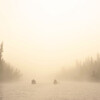
Escape the Crowds
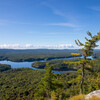
Killarney’s Most Beautiful Lakes
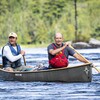
Quetico’s Best Canoe Routes
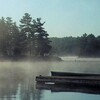
Best Places To Canoe Trip
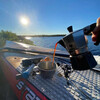
Best Paddleboarding in Sudbury
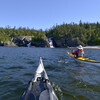
Paddling the Pukaskwa National Park Coast
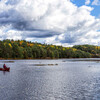
Backcountry tripping
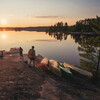
Imagine Paddling Quetico and Not Seeing Another Soul!
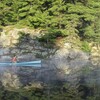
Discover Point Grondine
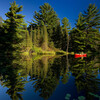
Old growth forests
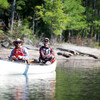
Find Wilderness South of Algonquin
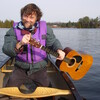
Songs About Canoeing
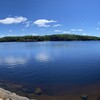
Woodland Caribou Canoe Trip
Temagami’s Prettiest Lakes
Canoe & Kayak Sault Ste. Marie
